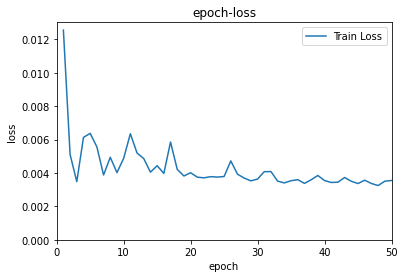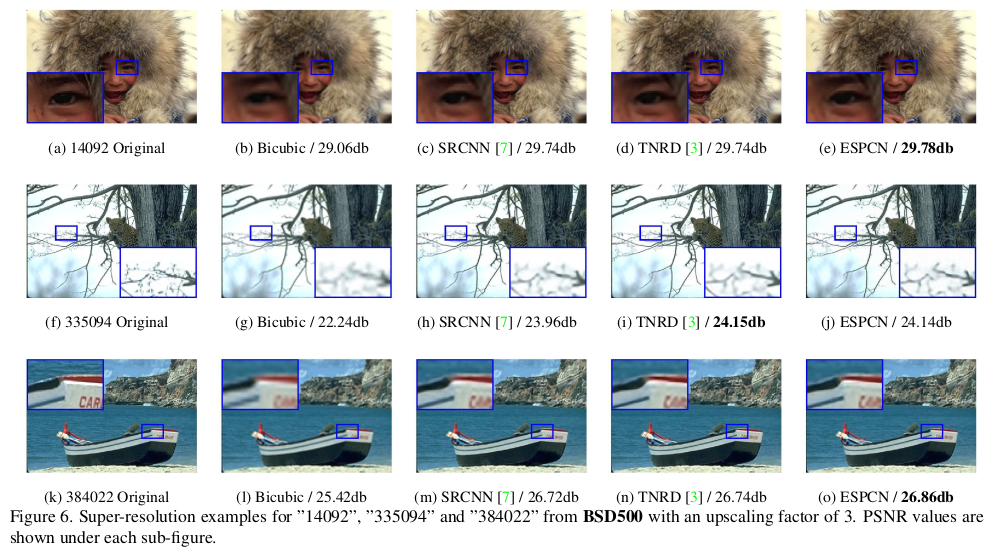ESPCN
Introduction
It is a re-implementation of paper named “Real-Time Single Image and Video Super-Resolution Using an Efficient Sub-Pixel Convolutional Neural Network” called ESPCN. Training codes and applying codes are provided based tensorflow.
Network proposed

In this place, $r$ represents the scaling ratio, eg. the input shape of LR is $a * a$ and output shape of HR is $ar * ar$
此处,$r$为放大倍数,如LR输入的shape为$a * a$,则输出shape为$ar * ar$

Processing Flow: Input (LR) -> 5x5 conv -> 3x3 conv -> 3x3 conv -> $r^2$ channels, the channel shape is $a * a$ -> reshape to $ar * ar$ (HR)
处理流程:LR输入 -> 5x5像素卷积 -> 3x3像素卷积 -> 3x3像素卷积 -> $r^2$个channel,每个channel的shape为$a * a$ -> reshape为$ar * ar$
Pixel Shuffle
Implementation
TensorFlow has a function which isn’t called Pixel Shuffle, while it truly works as Pixel Shuffle. The layer class is written bellow.
class Shuffler(tf.keras.layers.Layer):
def __init__(self,r):
# 调用父类__init__()方法
super(Shuffler, self).__init__()
self.r = r
def call(self, inputs):
x_c = []
for c in range(3):
t = inputs[:,:,:,c*self.r*self.r:c*self.r*self.r+self.r*self.r] # [B,H,W,R*R]
t = tf.compat.v1.depth_to_space(t, self.r) # [B,H*R,W*R,1]
x_c += [t]
x = tf.concat(x_c, axis=3) # [B,H*R,W*R,3]
return x
The old version of PixelShuffler.
class PixelShuffler(tf.keras.layers.Layer):
def __init__(self, target_shape, **kwargs):
super(PixelShuffler, self).__init__(**kwargs)
self.target_shape = tuple(target_shape)
print("init succeed.")
def build(self,input_shape):
# self.inshape = input_shape
print("build succeed.")
def call(self, inputs,color=True):
bsize,inh,inw,ind = inputs.shape
if bsize is None:
bsize = -1
h,w,d = self.target_shape
if ((h%inh!=0) or (w%inw!=0) or (ind%d!=0) or ((h/inh)!=(w/inw)) or ((h/inh)*(w/inw)!=(ind/d))):
raise Exception("Error! The shape of input and target is not corresponded.")
r = int(h/inh)
result = []
if color:
Xc = tf.split(inputs, 3, 3)
for x in Xc:
X = tf.reshape(x, (bsize, inh, inw, r, r))
X = tf.transpose(X, (0, 1, 2, 4, 3)) # bsize, a, b, 1, 1
X = tf.split(X, inh, 1) # a, [bsize, b, r, r]
X = tf.concat([tf.squeeze(x) for x in X],2) # bsize, b, a*r, r
X = tf.split(X, inw, 1) # b, [bsize, a*r, r]
X = tf.concat([tf.squeeze(x) for x in X],2) # bsize, a*r, b*r
X = tf.reshape(X, (bsize, inh*r, inw*r, 1))
result.append(X)
X = tf.concat(result,3)
else:
X = tf.reshape(inputs, (bsize, inh, inw, r, r))
X = tf.transpose(X, (0, 1, 2, 4, 3)) # bsize, a, b, 1, 1
X = tf.split(X, 1, inh) # a, [bsize, b, r, r]
X = tf.concat([tf.squeeze(x) for x in X],2) # bsize, b, a*r, r
X = tf.split(X, 1, inw) # b, [bsize, a*r, r]
X = tf.concat([tf.squeeze(x) for x in X],2) # bsize, a*r, b*r
X = tf.reshape(X, (bsize, inh*r, inw*r, 1))
X = tf.concat(result,3)
print("PixelShuffle Finished.")
return X
Results
After 50 epoches, the model performs not bad on train data.


The video has been uploaded to Tencent Video and Bilibili, Bilibili Link: Click me
As the Figure shows below (original from paper), the ESPCN proposed has a better result than other methods about SR problem like Bicubic and SRCNN.

Author
Wenkang Zhu
If you have or find any problems, this is my email: wenkang_zhu@whu.edu.cn. And I’m glad to reply it. Thanks.
Referrence
- Matlab Implementation on Github: https://github.com/wangxuewen99/Super-Resolution/tree/master/ESPCN
- CSDN Sub-pixel Convolution(子像素卷积): https://blog.csdn.net/leviopku/article/details/84975282
- Cnblog: https://www.cnblogs.com/xiaochouk/p/11337118.html
- Pixel Shuffle Impltmentation: https://blog.csdn.net/bbbeoy/article/details/81085652